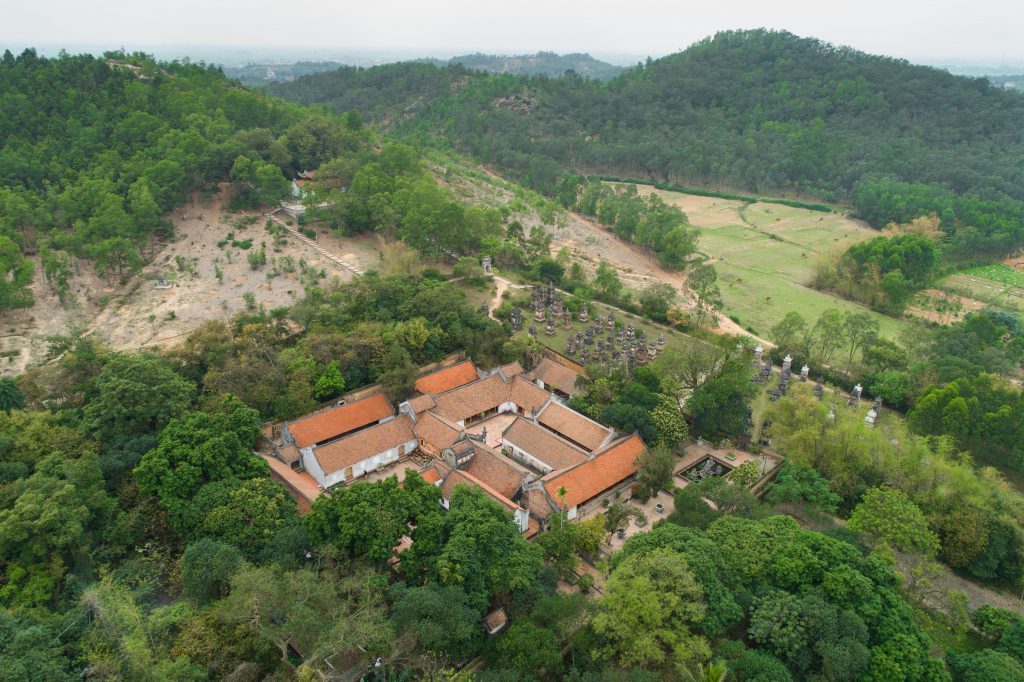Story: Thu Ha
Photos: Nguyen Phu Duc, Phan Hai Tung Lam
The northern province of Bac Giang is home to one of Vietnam’s most intriguing pagodas
Known as the “Northern capital”, Bac Giang province is famous for its mellow and heartfelt quan họ folk chants. Most visitors don’t realize that, as well as having a beautiful natural landscape, this province boasts some of Vietnam’s finest pagodas. One of these is Bo Da Pagoda, one of three ancient pagodas with rich cultural and historical values.

Nestled on Phoenix Mountain to the north of the Cau River in Tien Son Commune, Viet Yen District, Bac Giang, Bo Da Pagoda is the largest hubs of Lam Te Zen Buddhism in Vietnam. The pagoda’s proper name is Guanyin Pagoda of Bo Da Mountain, or Bo Da Mountain Guanyin Pagoda. It is commonly referred to as Bo Pagoda, Guanyin Pagoda or Tu An Pagoda.
Based on physical evidence and old accounts, the pagoda dates back to the Ly Dynasty. As legend has it, a kind hearted carpenter prayed for a son and was blessed by Guanyin Buddha. In return he built a shrine, painted a Songtzu Guanyin statue and paid sincere homage to it day and night. Eventually, passerby who paused to pray and make wishes found their lives going more smoothly, thus bringing fame to the pagoda.

Under the reign of Emperor Le Du Tong, the pagoda was reconstructed. At first, Bo Da Pagoda was meant exclusively for royal worship. Through various restorations, it was extended and drew many devout followers. Today, it draws Buddhist pilgrims, along with visitors who follow Confucianism or Taoism. Upon reaching this pagoda, everyone is Buddhist. However, as disciples are supposed to worship their masters, it is one of a few places to worship the Tri Religion.


Having survived cruel and turbulent times, Bo Da Pagoda is one of very few places to have retained its ancient Vietnamese architecture. It was designed to be “open on the inside and protected on the outside”, resulting in a solemn, melancholy and sacred atmosphere. Upon entering this pagoda, one can feel the welcoming vibe of the Northern countryside. The entry gate is reminiscent of the quintessential steeples that date back to the Nguyen Dynasty, the floor tiled with pebbles of different sizes. The surrounding walls were built of highly unique rammed earth and carved with sophisticated mosaic and ceramic bas-reliefs. The entire complex is vast and spans around 51,784sqm divided into three areas: the garden, the Main Hall and the stupa yard.

The garden is dotted with fruit trees and crops to feed the monks. The Main Hall comprises Tu An Pagoda, built in the Le Dynasty and designed to form the “Labor Character on the inside and Nation Character on the outside” – a quintessential feature of Vietnamese pagodas, and eight gates that represent the Eight Symbols, with Six Character aisles. The entire pagoda consists of 16 wings of different sizes and 100 compartments. Adjacent to the Main Hall is a thousand-year-old stupa yard encircled by embanked walls. Here, hundreds of stupas stand in layers, transporting visitors to another world. This dreamy, bleak, otherworldly and sacred place also holds sarira beads formed from the cremated remains of 1,214 monks and nuns. The stupa yard of Bo Da Pagoda is considered the largest and finest of its kind in Vietnam.

Its architectural and aesthetic values aside, Bo Da Pagoda also stores many accounts and artifacts of great cultural and historical value. The pagoda preserves statues dating back to the Le Dynasty and a colossal treasure trove of Chinese – Nom literature in all genres. The pagoda’s Buddhist scripture woodblock collection is one of the oldest of its kind in Vietnam and includes over 2,000 woodcuts inscribed on Diospyros decandra wood over 28 years from 1706 to 1734. Over three centuries, these woodcuts have remained well-preserved. They are noted in the 2006 Vietnam Book of Records.
Heaven and earth seem to meet over the distant rivers and mountains around Bo Da Pagoda, a sacred place that feels as friendly as the Bac Giang locals. In 2016, Bo Da Pagoda was registered as a Special National Site. Pilgrims come here to admire this ancient pagoda’s landscape and to gain insight into its cultural and historical treasures.










